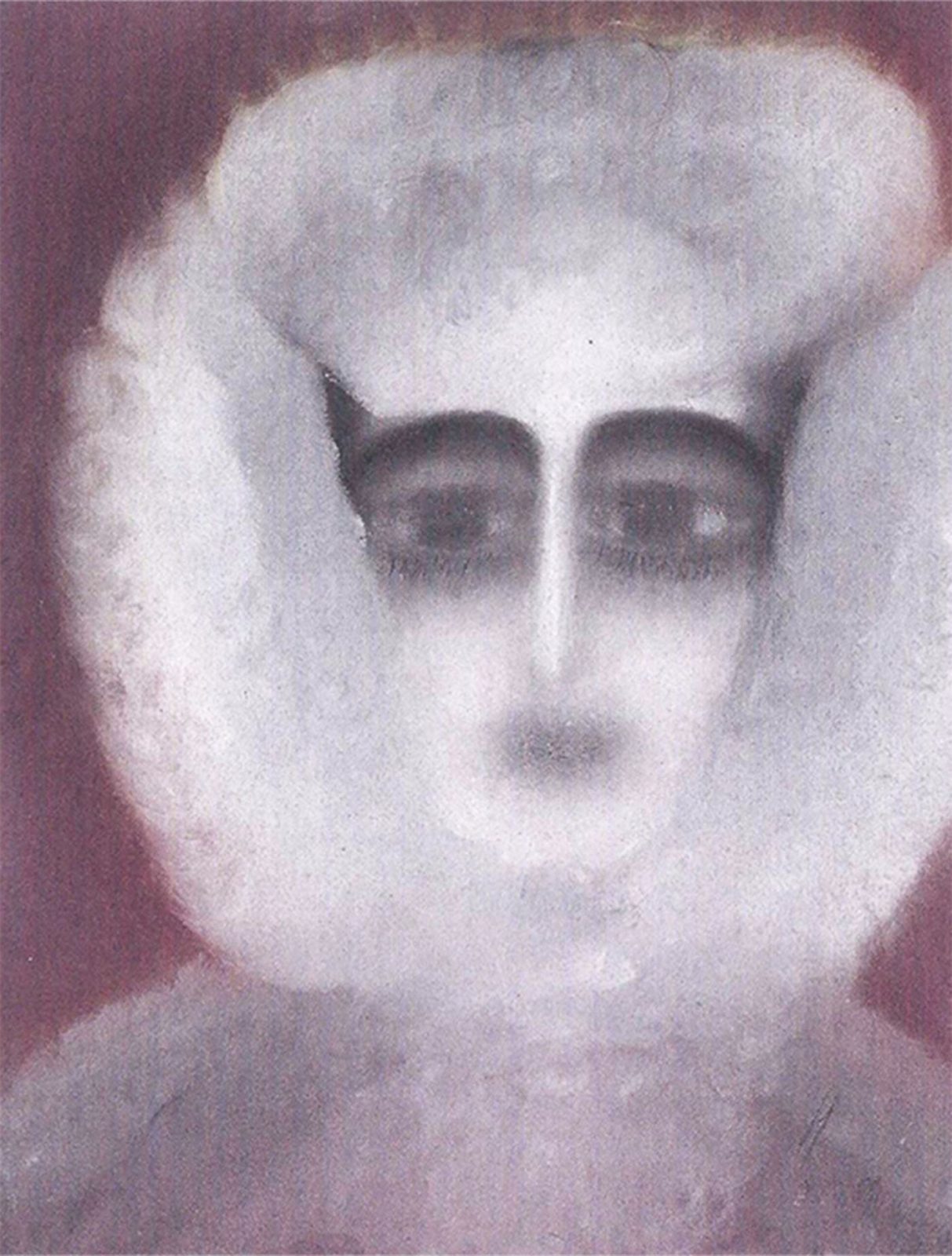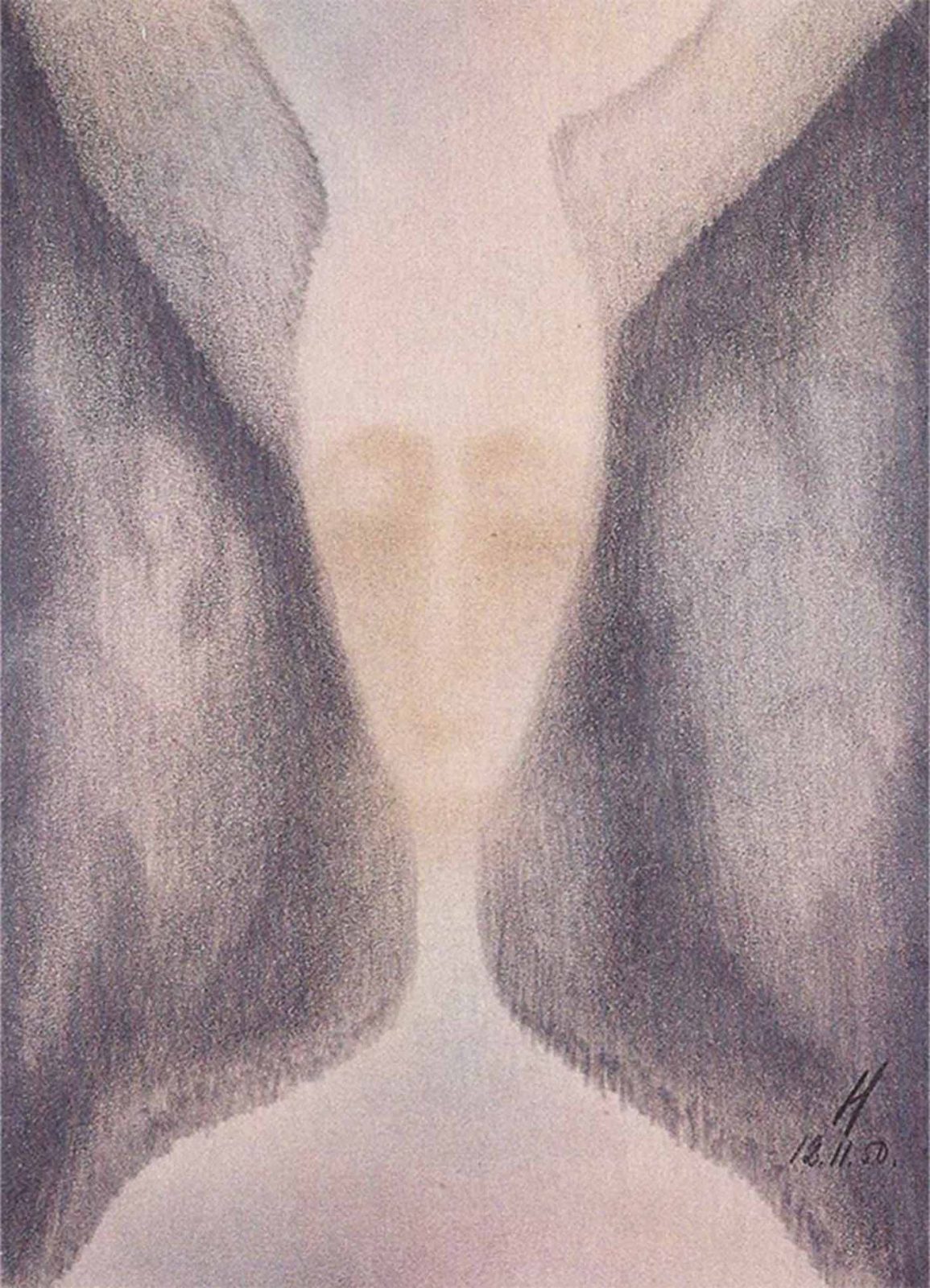
This story begins in various ways at various times with a very many beginnings. Perhaps it all commenced in 1899. Or in 1920. In 1926, 1931, 1946? 1990, 2021 or 2024. Perhaps it started even before, simultaneously and in between any of these dates. It may start as I write this, or as you read it. What’s certain is this story hasn’t ended, a thread has been drawn across times and realms. It continues onto the table on which I write and carries itself beyond. This story belongs to Aleksandra Ionowa and the invisible networks that bind women together.
Aleksandra Ionowa’s Early Life and Spiritual Development
Aleksandra Ionowa’s role in the spiritual development of humanity was as indisputable to her inner circle as was the importance of the visions recounted in her remarkable mediumistic art. Born in 1899 to a Russian family, she grew up and spent her life in Finland. The conflict between both countries was so important to her identity that throughout her lifetime she searched the spirit world for teachings and answers on peace. Her beliefs and creations were restorative ones, seeking to bring together followers with different spiritual belief systems and inclinations (Christians, Theosophists, Freemasons, Anthroposophists…) In so doing, she evolved as a key figure in early 20th century esotericism but, like many of her female mediumistic counterparts, was disregarded by the authority of Art History.

Image courtesy of “Aleksandra Ionowa: Visions of the Spirit World and Peace” Gallen-Kallela Museum, 2025 / The Aleksandra Ionowa Foundation.
When she met her life partner Selma Mäkelä in 1926, her path towards these spiritual realms solidified into becoming the backbone of their life together. Her role as a guide also heightened and expanded as she joined Ruusu-Risti, the Finnish Theosophical society. She was in contact with Masters such as Morya, Koot Hoomi, Saint Germain and Christ, transmitting the messages received through dreams and visions. Ionowa, like many of her female spiritual counterparts, was adamant in sharing what travelled through her: the teachings gathered and collected through the different orbits and voyages were communicated and spoken of. It was during the 1930s that both Mäkelä and Ionowa started to see these tidings as indicators of Aleksandra’s weight as an enlightened being.

Image courtesy of “Aleksandra Ionowa: Visions of the Spirit World and Peace”
The Gallen-Kallela Museum / Jukka Paavolainen.
A Spiritual Revelation and a New Path Forward
In 1946, with no prior artistic background, training or inclinations, Ionowa had an important spiritual revelation and began an expeditious outpouring of mediumistic drawings. The outcomes were varied, but most continual were the renditions of souls of people: ‘soul flowers’ she would gift to the people she believed they belonged to. With her ‘magic pen’ she also transcribed revelations as portraits of sacred beings. Beyond her distinctive unveiling through drawings of empyrean levels of consciousness, she began to play improvised music using only the black keys of the piano. Celestial conversations took on new forms:
‘That which I play, I draw, and that which I draw, I play.’
During her lifetime, the genius of her channelled creativity remained fairly unknown to the public, bar a showcasing of her work held in the parish hall of Lauttasaari with an accompanying publication (now of extreme rarity) titled The Heaven Was In Me. As always with the retellings of the histories of transgressive female artists worldwide, it is the extraordinary generosity, precision and care within the archives and of the women who then carry the story beyond the grave that show the astounding level of spellworkings within art.

Image courtesy of “Aleksandra Ionowa: Visions of the Spirit World and Peace”
The Gallen-Kallela Museum / Jukka Paavolainen.

Image courtesy of “Aleksandra Ionowa: Visions of the Spirit World and Peace”
Gallen-Kallela Museum, 2025 / The Aleksandra Ionowa Foundation.
An exhibition, text, book, film or oral history of the departed holds indescribable amounts of weight when harmonious communication between object and keeper is visible. Murmurs and breaths leading to coincidental discoveries in research are the most flamboyant sign that the vector is the correct one. It is without a doubt that Aleksandra Ionowa has traversed various planes and chosen to reach the ears, eyes, mouths and fingers of Anita Fagerholm, Nina Kokkinen and Vivienne Roberts respectively, without whom Aleksandra Ionowa may be assigned to the black holes of former times.
Aleksandra Ionowa’s Continued Journey
Each of these guardians have their own involvement with Aleksandra. Anita Fagerholm first saw works by this treasured informer in the late 1990s at a small exhibition in Lahti. Mumblings of the artist’s singular existence followed her until 2010 when she became acquainted with the Ionowa Society and the collection within it: “the collection was an exceptional entity in every way and should be brought to the public again.” Her task for “Aleksandra Ionowa: Visions of the Spirit World and Peace,” a recent and significant exhibition at the Gallen-Kallela Museum (Feb. 8–June 1, 2025) was to catalog and digitize over 1200 works of art from the collection whilst organizing its spilling contents for research purposes, becoming a precious helping hand for any other researchers. Fagerholm was preserving and regulating an unprecedented, “extensive and diary-like art collection.” Within the archive itself is a treasure trove and assembly of work depicting abundant spiritual realities ranging from planets to chakras, Kalevala, Freemasonry etc.

Image courtesy of “Aleksandra Ionowa: Visions of the Spirit World and Peace”
Gallen-Kallela Museum, 2025 / The Aleksandra Ionowa Foundation.

Image courtesy of “Aleksandra Ionowa: Visions of the Spirit World and Peace”
Gallen-Kallela Museum, 2025 / The Aleksandra Ionowa Foundation.

Image courtesy of “Aleksandra Ionowa: Visions of the Spirit World and Peace”
Gallen-Kallela Museum, 2025 / The Aleksandra Ionowa Foundation.
Nina Kokkinen’s discovery of the artist revolved around her personal research around connections between esotericism and the art of other well known male Finnish Artists. A whirlwind of media interest led to spontaneous liaisons with Kokkinen, as members of the public enthusiastically responded to her work and relayed the existence of the artist. A shadow hand was laying the foundations for a new comprehension of the strength within the passion of Ionowa and Mäkelä. Through this, Kokkinen was able to frame clairvoyance within the subject of Art History: “Although Mediumistic or Visionary Art has perhaps tended to be seen as a somewhat marginal phenomenon in the history of Modern Art, it plays an essential role in it. Her art offers a means and opportunity to explore clairvoyance from many different forms and perspectives expressed with such diversity of means and techniques.” Not only did Kokkinen find the Masonic robes belonging to both Aleksandra and Selma, but whilst (brilliantly) curating and researching the exhibition of Ionowa’s works for Aleksandra Ionowa: Visions of the Spirit World and Peace, Nina Kokkinen was trusted with a brilliant secret. The letter ‘H’ Ionowa so mysteriously signed her works with were initials of another: Aleksandra Ionowa was signing her works as Helena P. Blavatsky. This guarded secret was relayed to Nina by a family member of Aleksandra’s close inner circle: they believed Ionowa was the incarnation of Blavatsky. And so, like a quadrille, a secret danced in and out of the archive to reveal itself as the network of women beyond time pieced and presented this story. Aleksandra Ionowa was continuing to sharpen.
She evolved as a key figure in early 20th century esotericism but, like many of her female mediumistic counterparts, was disregarded by the authority of Art History.
Through a different time network of the curious and in the UK, Vivienne Roberts was whispered the name of Ionowa too. Mari Sunna was holding slivers of the soul’s baton, passed it to Jacqui Macintosh who, in a gust of great kindness, safely entrusted Vivienne Roberts with the gathered traces of the subconscious of Ionowa. The breeze landed in the safest of places. Roberts is considered by all who come across her labour as being the chaperone of mediumistic and visionary artists. Though she speaks of it as her specialty, onlookers ogle at her unselfish gift: it was through the Creative Spirits exhibition at The College of Psychic Studies in London that Ionowa’s work was first exhibited outside of Finland and her article in Raw Vision Magazine the first time Ionowa was written about in the English Language. It feels safe to hear of these stories through Vivienne who completes the awe-inspiring crossing between pulses to care for translucent pasts. Vivienne Roberts is well-acquainted with the crucial significance of visionary art, once overlooked and ignored, but now beginning to uncurl its dainty shoes in the snowy canon of art history, with a very significant message: ‘in times of uncertainty and fear, their work brings hope and healing.’
A secret danced in and out of the archive to reveal itself as the network of women beyond time pieced and presented this story.
To structure the timeline story with a beginning, a middle or an end specifically would be to limit its dendriform shape. There are no limits to the branches and wonder of this mediumistic twister. The way Aleksandra Ionowa’s journey continues shows it is vital to tell each other of the extraordinary, sing its praises and feel its healing. The fact you witnessed it simply means you’ve been entrusted to carry it too.
There’s a reason soul flowers have many petals.

Image courtesy of “Aleksandra Ionowa: Visions of the Spirit World and Peace”
The Gallen-Kallela Museum / Jukka Paavolainen.
Featured image: Aleksandra Ionowa, “Helena Blavatsky,” 1950. Image courtesy of “Aleksandra Ionowa: Visions of the Spirit World and Peace,” Gallen-Kallela Museum, 2025 / The College Of Psychic Studies, London. Photo: Anita Fagerholm.
The post Channeling Peace: Aleksandra Ionowa’s Esoteric Art appeared first on A Women’s Thing.